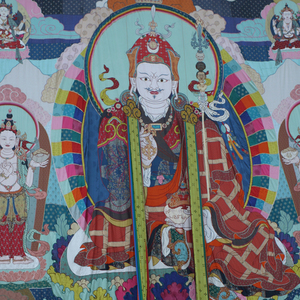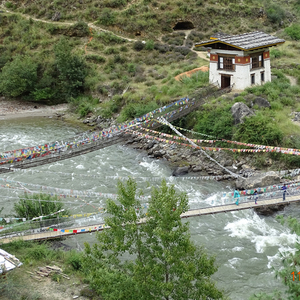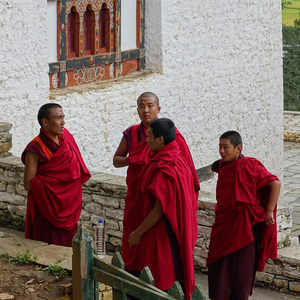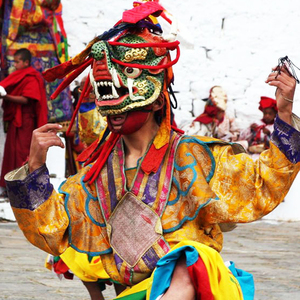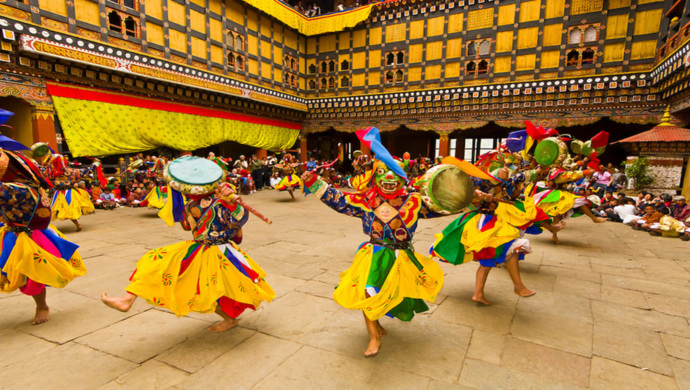
Paro Tshechu Festival
Bhutan is not only full of ancient monasteries and forts but also replete with colorful festivals. Each monastery or Dzong holds an annual festival (Tshechu) which has a dual purpose, one, as a social occasion, and two, as an occasion to keep alive the teachings and philosophies of Buddhism. The Tshechus are held to honor and celebrate the birth and great deeds of Guru Padmasambhava, considered as second Buddha. It features dances performed by trained monks and laymen in amazing masks and costumes. Tshechu are one of the best ways to experience the ancient living culture of Bhutan. Tshechu, derived from the local Dzongkha Term meaning the “10th Day”, is conducted on and around the auspicious 10th day of a selected month according to lunar calendar, once every year. The festival ranges from 3 – 5 days. This tour showcases one of the most important festivals in Bhutan – Paro Tshechu. This is held annually at Rimpung Dzong in Paro. It is generally held in the month of March or April.
Brief Description of Cities covered in this tour
Thimphu: Capital and the largest city of Bhutan - Only capital city in the world that does not have traffic lights - Main center of Commerce, Religion and Government in the country - Most modern city of Bhutan and has abundance of restaurants, internet cafes, nightclubs and shopping center. It is one of the few cities of Bhutan having ATM facilities.
Paro: Small town in the western part of Bhutan - Also home to Paro Airport, Bhutan’s only International Airport - The valley has many isolated small villages and is known for red rice - Also home to most of Bhutan’s oldest temples and monasteries.
Punakha and Wangdue: Punakha and Wangdue is located in the same valley. These two places are located within a distance of 13 km. Punakha was the capital of Bhutan and the seat of government until 1955 - The valley is fed by the Pho Chhu and the Mo Chhu rivers - It is one of very few places in Bhutan which offers Rafting facilities - It is the winter seat of the Je Khenpo (Chief Abbot) and the monk body at present.
- View sacred dances and rituals performed by monks and laymen in elaborate costumes.
- Join in with locals in a special occasion of celebration, blessings and socializing.
- Witness the unfurling ceremony of the sacred ‘Thongdrol’ scroll at daybreak.
- Visit Tashichhodzong and Punakha Dzong – two of the most impressive Dzongs (fortresses)
- First hand experience of Bhutanese way of life and traditional rural villages.
- Untouched Nature and unique Art & Architecture
- Untouched Buddhist Culture.
- Hike through pine forests to visit “Tiger’s Nest”
- Beautiful landscapes and spectacular Himalayan scenery.
- The must visit Dochula Pass and the Druk Wangyal Chhortens
Day 1. Arrive Paro:
Altitude of Paro: 2,280 m
Your flight to Paro on a clear day, is marked with the panoramic views of the Himalayas including the Everest and other famous Peaks. The approach through the foothills and the landing (including few steep turns) at the tiny airstrip of Paro has been termed as adventurous by many travelers. After the completion of immigration formalities at the Paro Airport exit door, you will be received by your Bhutanese guide with traditional “Tashi Khadar”. Thereafter you are driven to your hotel and do your check in. After lunch, visit,
- Ta Dzong, an ancient watch tower overlooking Rimpung Dzong built in 1951 now converted into national museum.
In the evening, explore the Paro Town and valley.
Meals – Lunch and Dinner; Overnight at the Hotel in Paro.
Day 2. Paro Sightseeing:
Festival Day 1
After breakfast, you will be taken to
- Paro Rimpung Dzong, also known as Fortress of the heap of jewels, built during the time of Shabdrung Ngawang Namgyal in 1646
Here you would enjoy the day 1 of the festival.
- Day 1 – Inside the Dzong, today the performances would cover:
- Shinje Yab Yum: Dance of the Lord of Death and his Consort - Bodhisattva Manjusri – representing the wisdom of all Buddhas – takes on the appearance of the terrifying Lord of Death (Shinje). His wrathful buffalo face guards the four continents.
- Durdag: Dance of the Lords of the Cremation Grounds - A dance that takes place in cremation grounds. The dancers wear skull masks and represent protectors of the religion who live in the eight cremation grounds on the periphery of the symbolic Mt. Sumeru.
- Zshana: Dance of the Black Hats - The black hat dancers assume the role of yogis with the power to subdue and create life. The dancers wear brocade robes, wide brimmed black hats and aprons with the face of a protective deity. This is an important dance that is also used in purification ceremonies during the construction of Dzongs, Temples, Chhortens.
- Dramitse Nga Cham: Dance of the Drums from Dramitse - A dance inspired in meditation. The dance is a vision of Guru Rinpoche and his celestial palace, Zangtopelri. Here, Guru’s attendants are transformed into hundreds of peaceful and terrifying deities. The dance originated in Dramitse Monastery in eastern Bhutan and is considered a Bhutanese heritage.
- Degye: Dance of the eight kinds of Spirits - A dance of the gods of the three worlds (sky, earth, underground). The gods protect the doctrines of the Buddha and subdue the spirits who make the world unhappy. Endless happiness is recovered. The dance is performed by the gods (believed to be incarnated in the dancers themselves) to renew faith and wisdom.
- Religious Songs – Chhoshey - This commemorates the opening of the gateway to the pilgrimage site of Tsari in eastern Tibet by the founder of the Drukpa School of Buddhism, Tsangpa Jarey.
You would see how may locals from far off places dressed in their finest clothes come to watch masked dances, to pray, to feast and to enjoy the atmosphere. We would arrange a local monk who would explain the event in detail.
For lunch you would be taken to a local restaurant. After the end of the first day, you would be drive back to the hotel. Evening free for leisure.
Meals – Breakfast, Lunch and Dinner; Overnight at the Hotel in Paro.
Day 3. Paro Sightseeing:
Festival Day 2
After breakfast, you would again be driven to Rimpung Dzong, to enjoy the day 2 of the festival.
- Day 2 – Outside the Dzong, today the performances would cover:
- Shinje Yab Yum: Dance of the Lord of Death and his Consort - same as Day 1 No. 1 dance
- Shana Nga Cham: Dance of the Black Hats with Drums - A dance to signify the victory of religion over enemies. The sound of the drum represents religion itself.
- Dance of the three kinds of Ging, with Sticks, with Swords and with Drums - A dance signifying the subjugation of demons that are obstacles to religions. It takes place in Zangtopelri, the heavenly palace of Guru Rinpoche.
- Durdag: Dance of the Lord of Cremation Ground - same as Day 1 No. 2 dance
- Shawa Sachhi: Dance of the Stag and the Hounds (1st part) - The dance tells a favorite tale of Milarepa who converts a hunter to Buddhism.
Apart from a time to wear beautiful fineries, eat good food and socialize, the Tshechu imparts religious values. Again there would a local monk who would explain the event in detail. There would be a local monk who would explain the event in detail.
For lunch you would be taken to a local restaurant. After the end of the day, you would be drive back to the hotel. Evening free for leisure.
Meals – Breakfast, Lunch and Dinner; Overnight at the Hotel in Paro.
Day 4. Paro Sightseeing:
Festival Day 3
After breakfast, you would again be driven to Rimpung Dzong, to enjoy the day 2 of the festival.
- Day 3 – Today, the performances would cover:
- Durdag: Dance of the Lords of Cremation Grounds- Same as day one, Dance No. 2
- Tungam: Dance of the Terrifying Deities - Dressed in beautiful brocade and terrifying masks, this is a deeply symbolic dance where a sacrificial murder is performed. Guru Rinpoche appears in a wrathful manifestation to save the world. The dance is meant to show all beings the way to salvation.
- Guan Drug Pawos & Kyecham: Dance of the Heroes with six kinds of Ornaments - The heroes hold six ornaments – five rings of bone ornaments and a small drum and bell in their hands. By their gestures and the sound of their melodies, the heroes lead sentient beings from the wheel of reincarnation along the path of liberation. Kyecham is an accompanying dance to the next dance. The Kyecham dancers wear knee-length yellow skirts, and animal masks.
- Pholeg Moleg: Dance of the Noblemen and Ladies - A comical play that depicts the life of King Norzang. The play is full of bawdy and rustic humor as two princes and two princesses, and old couple and clowns enact a story of misbehavior, deceit, and mistrust. The story ends happily with the princes marrying the princesses and reconciliation takes place as a lesson to life.
- Shawa Shachhi - Lencham: Dance of the Stag and the Hounds (IInd part) - This is a conclusion of the dance began on the second day. The saint Milarepa appears in a long white dress and converts the dogs, stag and the hunter with a song. The conversion is symbolized by the hunter and his dogs jumping a rope.
Apart from a time to wear beautiful fineries, eat good food and socialize, the Tshechu imparts religious values. Again there would a local monk who would explain the event in detail.
For lunch you would be taken to a local restaurant. After the end of the day, you would be drive back to the hotel. Evening free for leisure.
Meals – Breakfast, Lunch and Dinner; Overnight at the Hotel in Paro.
Day 5. Paro Sightseeing:
Festival Day 4
After breakfast, you would again be driven to Rimpung Dzong, to enjoy the day 2 of the festival.
- Day 4 – Today, the performances would cover:
- Shinje Yab Yum: Dance of the Lord of Death and his Consort - Same as day 1, Dance No. 1
- Sha Tsam: Dance of the four Stags - A dance that depicts Guru Rinpoche subduing the God of Wind who is believed to have created unhappiness on earth. Dancers dress as stags in yellow knee length dress and masks of the deer. The stag represents the mount of the God
- Raksha Mangcham: Dance of the Judgment of the Dead - This dance is based on the Bardo (Book of the Dead). When beings die they wander in an intermediate state known as the Bardo. They cross the Bardo to meet their judgment by the Lord of Death. Also present is the white god and black demon who have been with every being from birth. The dance is like a play which depicts the judgment of a sinner and a virtuous man who goes to heaven. The Rakshas are the helpers of the Lord of Death.
- Dramitse Nga Cham: Dance of the Drums from Dramitse - Same as Day 1, Dance No. 4
It is also believed that the mask dances in the Tshechu is also guidance to the people on earth about after life. Again there would a local monk who would explain the event in detail.
For lunch you would be taken to a local restaurant. After the end of the day, you would be drive back to the hotel. Evening free for leisure.
Meals – Breakfast, Lunch and Dinner; Overnight at the Hotel in Paro.
Day 6. Paro - Thimphu:
Distance: 65 kms, Driving Time: 2 hrs, Altitude of Thimphu: 2350 m,
Festival Day 5
After breakfast, you would again be driven to Rimpung Dzong, to enjoy the day 2 of the festival.
- Day 5 – Today, the performances would cover:
- At around 3.30 – 4.00 AM, the Great Paro Thongdrol is unfurled and a Shugdrel ceremony performed. This is done before sunrise and most people rush to witness the moment as it is believed that our bad karma is expiated just by viewing it.
- Pacham: Dance of the Heroes - A dance to lead believers in the human world into the presence of Guru Rinpoche.
- Dance of the Ging and Tsholing - Guru Rinpoche initiated this dance during the consecration of the ancient Samye Monastery in Tibet. The dance is a purification ceremony. People whistle to chase away bad spirits. The Ging, dressed in orange skirts and a terrifying mask, use their drumsticks to hit everyone on the head to drive out impurity. The Tsholing represent protectors of the religion and are dressed in long colorful dresses and terrifying masks.
- Guru Tshen Gye: Dance of the Eight Manifestations of Guru Rimpoche - This dance is one of the highlights for Buddhist practitioners. The Guru appears in eight different forms in a dance that is also a play.
- Rigma Chudrug: Dance of the Sixteen Fairies - After all eight manifestations appear, 16 fairies sing and perform two dances in front of the Guru. The fairies are Goddesses of Offerings who perform a dance to bring happiness. They are dressed in brocade dresses with carved bone ornaments. After these final songs, the manifestations go out in a long procession.
Local people believe that everyone must attend a Tshechu and witness the mask dances at least once in their life in order to receive blessings and wash away their sins.
For lunch you would be taken to a local restaurant. Later in the day you are driven to Thimphu. Evening free for leisure.
Meals – Breakfast, Lunch and Dinner; Overnight at the Hotel in Thimphu.
Day 7. Thimphu Sightseeing:
Today you would be driven in and around Thimphu covering key places of interest. After breakfast you would visit
- Kuensel Phodrang, the gigantic Buddha Dordenma Statue located atop a hill in Kuensel Phodrang Nature Park.
- National Memorial Chhorten, a Stupa built in 1974 to honor the third Druk Gyalpo, Jigme Dorji Wangchuck. Every morning till night old people and young people circumambulate the Chhorten. You may choose to light butter lamps and also circumambulate around the Chorten.
- Zorig Chusum, Premier institute of traditional arts and crafts in Thimphu established with an objective of preserving “thirteen arts and crafts of Bhutan”.
- Folk Heritage, traditional house giving an insight to the Bhutanese lifestyle, and artifacts from the rural households
Thereafter you would be taken to a local restaurant for lunch. In the afternoon you would be taken to
- Sangaygang View Point, also known as BBS Tower offering panoramic view of Thimphu Town situated at an elevation of 2,685 m.
- Changangkha Monastery, popular fortress like temple perched on a ridge above Central Thimphu built in 15th Century by Lama Phajo Drugom Zhipo.
- Takin Preserve Centre, see Takin (National animal of Bhutan) It is a unique combination of Goat and an Antelope
- Tashichhodzong, or ‘the fortress of the glorious religion’. Initially erected in 1641 by Shabdrung Ngawang Namgyal, it was rebuilt in the 1960s during the reign of Bhutan’s third king in the traditional style, without plans or nails. It houses some ministries, His Majesty’s secretariat, and the central monk body and opens after 5 PM.
After the completion of sightseeing, you are driven back to your hotel. After relaxing for sometime you are served with dinner.
Meals – Breakfast, Lunch and Dinner; Overnight at the Hotel in Thimphu.
Day 8. Thimphu - Punakha/Wangdue Sightseeing:
Distance: 77 kms, Driving Time: 3 hrs. Altitude of Punakha: 1310 m.
After breakfast and completion of Check Out formalities you are driven to Punakha/Wangdue, for your next leg of the tour. On the way, you would stop at
- Dochula Pass, lies at an elevation of 3,150 m and is a great place to view the higher Himalayas. The landmarks around the pass includes 108 Druk Wangyal Stupas built under the patronage of Queen Ashi Dorji Wangmo Wangchuk.
After arrival at Punakha, check in to the hotel. After lunch, you would visit
- Punakha Dzong, built in 1637 by Shabdrung Ngawang Namgyal. For many years until the time of the second King, it served as the seat of the Government. It is still the winter residence of Je-Khenpo (The Chief Abbot of the Central Monastic Body of Bhutan).
- Chhimi Lhakhang, a famous Temple, which is also known as “The Temple of Fertility” built by Lama Drukpa Kuenley.
Evening free for leisure activities.
Meals – Breakfast, Lunch and Dinner; Overnight at the Hotel in Punakha/Wangdue.
Day 9. Punakha - Paro:
Driving Distance: 135 Kms, Driving time: 4.50 hrs – 5 hrs, Altitude of Paro: 2,280 m
After breakfast, you would check out of the hotel to proceed to Paro, final leg of the tour. On the
way stop at
- Royal Botanical Park, Lamperi, also known as the Rhododendron Garden, is the first Botanical Garden of Bhutan. It is famous for 46 species of rhododendrons.
Further, stop at
- Tamchog Lhakhang, located along Paro-Thimphu highway on the base of a mountain across the Pa Chhu river built in the early 15th century by the great iron bridge builder Thangtong Gyalpo.
After arriving at Paro, you would be transferred to you Hotel for Check In. After lunch, you would be taken around to visit
- Ta Dzong, an ancient watch tower overlooking Rimpung Dzong built in 1951 now converted into national museum.
Evening is free for leisure activities and shopping.
Meals – Breakfast, Lunch and Dinner; Overnight at the Hotel in Paro.
Day 10. Paro Sightseeing:
After breakfast, start your day with a hike to:
- Taktsang Monastery (Tiger's nest), the abode of gods and monks situated at an altitude of 3100m on the Upper Paro Valley, Bhutan. As per the legend, Guru Padmasambhana (Guru Rinpoche), the tantrum mystic who brought Buddhism to Bhutan, came in the form of Dorje Droloe riding a flying tigress to subdue the demon that was obstructing the spread of Buddhism in the Himalayas.
After the completion of the hike, you would be served picnic Lunch among the woods. After lunch, visit
- Kyichu Lhakhang, one of the oldest monasteries in Bhutan built in the 7th century by the Tibetan Emperor Songtsen Gampo.
You would then drive to village house to witness the traditional rural life in a Bhutanese village. Also you have an option of experiencing a Traditional Hot Stone bath in the village house. You can also choose to have your dinner in the house with the Family or be driven back to your hotel.
Meals – Breakfast, Lunch and Dinner; Overnight at the Hotel in Paro.
Day 11. Departure:
Today we will bid farewell to this beautiful country and take an early flight back. We hope by now you mist have made some good friends and also have taken photographs and beautiful memories of Bhutan. We certainly hope of serving you again on your next visit to this great country or the Last Shangri-La. Tashi Delek


